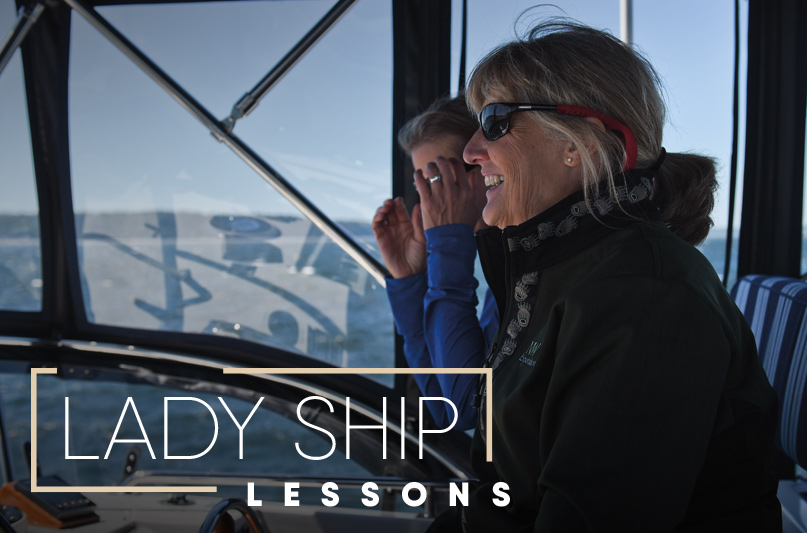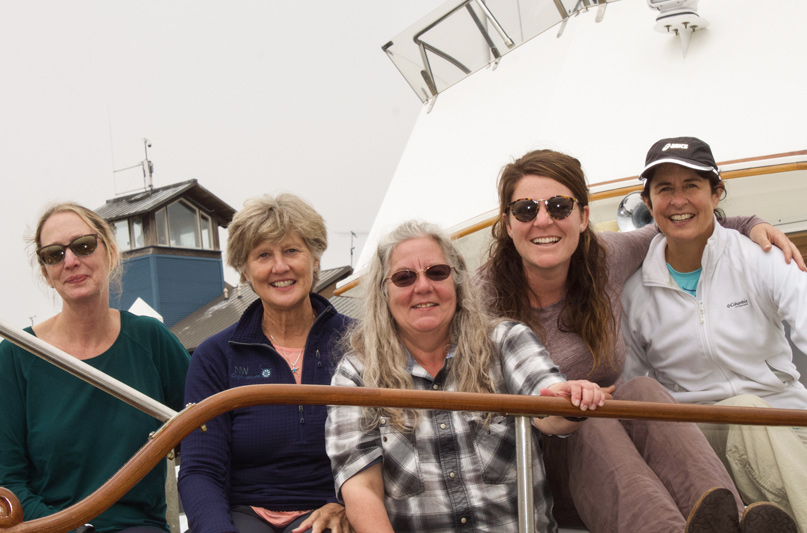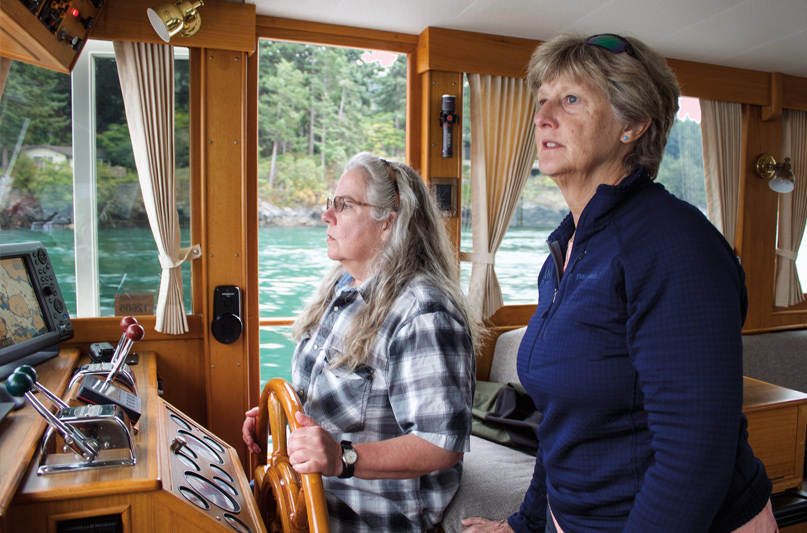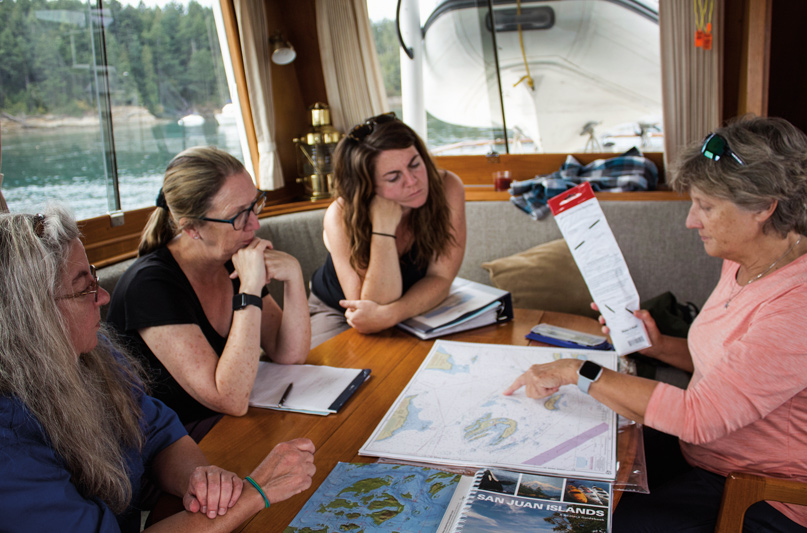
 The human desire to be the captain of our own ship is fundamental. To plot your course, take the helm, and sail to your chosen destination is a perfect metaphor for life both on and off the water. Let’s not forget enjoying the journey along the way, too. Of course, finding your way in life can be much harder than finding your way on the Salish Sea, yet barriers that some of us face on land are the same hurdles we face on the water. Take women and powerboating. We often find ourselves sidelined as passenger-crew when what we want is to take the helm as skipper.
The human desire to be the captain of our own ship is fundamental. To plot your course, take the helm, and sail to your chosen destination is a perfect metaphor for life both on and off the water. Let’s not forget enjoying the journey along the way, too. Of course, finding your way in life can be much harder than finding your way on the Salish Sea, yet barriers that some of us face on land are the same hurdles we face on the water. Take women and powerboating. We often find ourselves sidelined as passenger-crew when what we want is to take the helm as skipper.
To change that dynamic, four women, including myself, completed a multi-day power training course presented by NW Explorations exclusively for woman. According to a BoatUS survey, many women believe there are not enough learning opportunities just for females, so the Bellingham, Washington-based company decided to offer all-female training weekends.
All of us are strangers, who have come together to go into unknown territory. We started our weekend by boarding Thea, a beautiful 46’ Grand Banks powered by twin 300-horsepower Caterpillar engines. She’s substantial and powerful, and we were going to learn how to “man” this imposing 19.5-ton vessel. Let’s be honest, the idea of anyone controlling an almost 20-ton vessel with two powerful engines is just a little audacious, no matter what your gender!
The first night Thea remained docked in Squalicum Harbor while the crew went out to dinner and formed an immediate bond. We were all here for the same reason—trust. We felt safe among other women to make mistakes and expose our ignorance. You might say, we were all in the same boat. Over the course of Labor Day weekend, our instincts about trust proved true and this group of strangers became friends.
Saturday morning, our captain—the intrepid Captain Paulette Bergh, known as Captain Paulette to all—came aboard ready to play. I would follow Captain Paulette anywhere. This woman was part of a Himalayan rescue team, sailed in almost every one of the world’s oceans, and could park a yacht on a dime. She has trained people to handle boats for decades and has worked at NW Explorations for 12 years. Best of all, she was a teacher extraordinaire.
Under her supervision, I was able to saddle Thea right up to the dock in the harbor during docking practice. Eventually. One time, I was heading straight for the pier. “Where do you think you will end up?” Captain Paulette calmly asked.
I replied, “I’m going straight to the pier.” I was apparently heading straight through the pier. She gently covered my hand that was clutching the joy stick and put the starboard engine in reverse. “It’s better if you parallel the dock,” she said, soothing both my fear and ego. According to the instruction manual, ego is the biggest impediment to docking.
She showed the same degree of kindness and patience to each one of us. In turn, that attitude was reflected by the crew. My three mates couldn’t have come from more disparate backgrounds, yet we enjoyed each other’s company and were always ready to lend a hand and cheer each other on. No one was telling us how to do it or saying, “Step aside, I’ll do it.”

Above (left to right): Melissa, Captain Paulette, Cheryl, Kaitlyn, and I are all smiles after our successful cruise exploring the Salish Sea and learning the necessary skills to master the sea on a motoryacht.
We all had our reasons for being on board. Cheryl, the smallest and fiercest one, has a great story on why everyone should know how to handle a boat. She was on a cruise up the Inside Passage with her family. The men decided to take the inflatable out and managed to slash it on a shoal full of oyster shells.
In the meantime, the wind picked up and the anchor gave, setting the boat adrift. Cheryl and her sister-in-law were the only two aboard. Her brother-in-law yelled, “Start the engines!” Cheryl yelled back, “How the hell do you do that?” She’s taking this course to learn exactly how to start the engine and drive the dang thing so when they take the boat to Alaska next summer, she’ll be prepared.
Melissa is preparing to go on a flotilla trip up to Alaska this fall. She and her boyfriend are sailors, but the last flotilla trip they took up to Desolation Sound was cold and miserable. There was no wind and they were always the last into port. “We went aboard a powerboat and they had hot coffee, and it was so comfortable,” she told me. They decided next trip would be on a powerboat and she wanted to have the skills to handle a substantial motoryacht.
I am on board because there was a last-minute opening and Northwest Yachting’s managing editor Norris Comer offered, “We need a feature. Want to learn how to drive a yacht?” I have been on cruises through the Gulf Islands with friends, but was always told what to do. I was the passenger.
Kaitlyn is the spark on the trip, game to do anything. She is 29 years old and lives on a Carver motorboat in a Ballard marina as an alternative to Seattle’s high rents. She loves it and is thinking about buying a boat, but also wants to feel confident enough to take a boat out into the Salish Sea. Kaitlyn likes to go fast, but Captain Paulette reminded her that speed comes with a cost.
“There is a point when you are burning so much fuel going fast that you might as well be throwing $20 bills behind you,” says Captain Paulette. She is one of the few female powerboat licensed captains who also instructs aboard sailboats and motoryachts in the Salish Sea. Besides training future captains and piloting charter boats, Captain Paulette leads an all-women flotilla down in Caribbean almost every year. Her team-building skills are apparent, skills she honed while teaching leadership and sailing to MBA students.
Training an all-female crew is one of her favorite jobs. “It’s better to train strangers than a couple,” she says. When boating, the dynamics of a marriage become apparent, and “I’m not Dr. Phil,” Captain Paulette says with a roll of the eyes.
Throughout the weekend, she leads us with encouragement and humor that is a perfect combination for learning. And wow, there is a lot to learn! Maneuvering, navigation, docking, man overboard procedures, and line handling are just some of the topics covered.
With so much to absorb, we don’t mess around. Tying line was the first order of business. The lines keeping the boat in its berth were beautifully ensconced in circles called Flemish coils. However, Captain Paulette pointed out that if it’s raining or dewy out, the lines will dry out more quickly using a daisy chain so air flows through. We practiced our knots; the cleat hitches to secure the boat and clove hitches to secure fenders.
Cheryl has been practicing at home, and even has an actual cleat to practice on. She also had the book Knot It, which she generously donates to me at the end of the weekend. I struggled with my knots.
I was practicing my cleat hitch when a man, who was trying to be helpful, came up and said “Here, let me show you how,” and attempted to do it for me. I explained the situation—that I was learning and needed practice—and thanked him. There was no mansplaining, no matter how well intentioned, aboard Thea. It’s another reason to be grateful for an all-female crew. With this crew there is no drama; just an intense desire to learn all things boating.
Next, we practice docking. We learn the beauty of neutral and why it’s important to dock close enough to the pier so a person can step off the boat and not into the water. From the flybridge, we practiced controlling this heavy boat with Captain Paulette’s special sauce—leave starboard in reverse and move the port engine from forward, through neutral, to reverse (called 1-2-3). It worked because none of us took out a dock! Thea does not have bow thrusters. Thrusters would have made things too easy.

However, we were not roughing it on Thea. There is a nice galley complete with a stove and a refrigerator guaranteed to freeze your lettuce and keep the wine chilled. We don’t spend much time in the galley, and chat in the comfortable salon that has room for all of us and a settee that can be a nice sleeping spot. With a couple steps down, you find a head and two berths forward. Lift the stairs up and you’re in the engine room. An en suite master berth is aft. Thea is a comfortable boat for the five of us.
Saturday afternoon, we motor to Sucia Island and anchor in Echo Bay. I love life on the hook. We popped a prepared meal into the oven and learned about the engines while dinner cooks. It’s dark and cramped in the engine room and we go down in pairs to face the belly of the beast–the two huge engines. We double checked oil levels and made sure the water system is functioning.
One of the most important elements to control on a powerboat is the power itself. So obvious, right? We learn about the generators, batteries, and electronics. I take note that it’s better to shower in the evening, after the hot water heater has been primed by the engines running all day.
We were practicing anchoring in Echo Bay when a grandmother and her granddaughter paddled by us in their kayaks. She asked if we were all-women crew. Yes, we responded. “Ahh, it’s a lady ship,” the woman told her granddaughter. “That’s wonderful.” The five of us beamed.
By the second day, we were really starting to become a crew and feel like Thea was our ship. We launched the dinghy, cruised around Echo Bay, and then put it back on the davit without a problem. Of course, reality pushed back and checked our egos. The windlass lost power for some reason and the anchor sunk back into Echo Bay, but like all failures, this became an opportunity to learn.
Luckily, the boat’s systems are redundant. If something breaks, there is always a back-up. Captain Paulette took this hiccup in stride because boating is all about something going wrong or the unexpected happening. We stopped the chain from completely unspooling and learn how to manually draw up the anchor. Who would have thought the anchor was stored behind Cheryl’s berth?
Heading into Friday Harbor from Sucia on Sunday morning, we all took turns driving and being the look-out. There was so much afloat in the Salish Sea. You look at things differently on the water; the dangerous logs floating indiscriminately, the kelp beds that can strangle engines, the porpoises surfing, and the humpback whales breaching. What was startling to me was the speed of the ferries. From the shore, they seem to be lumbering, but close up and on the water, they are speed demons.
We made it to Friday Harbor without incident, each of us enjoying our time at the helm. In contrast with Sucia’s serenity, Friday Harbor boomed with activity. It was Labor Day weekend, after all. Melissa took over at the helm and was nervous about parallel parking between two very expensive yachts. “I am freaking out and that’s a nautical term,” Melissa said. She slipped into the slip without a hitch. We all applauded. It was a masterful parking job.
Here in Friday Harbor with all its resources, my education broadened with rum knowledge. Essential knowledge for a sailor, apparently. Mount Gay rum was the winner of the taste test and we raised our glasses in a toast to women boating. At that moment, I never wanted to get off the boat.

But Monday dawned with fog lifting off the water, and it was time to go back to where we started. We had a quick navigation lesson before getting underway, learning how to employ a divider and parallel rulers. I finally understand the meaning of compass rose, how it compensates for location in determining true north. As our captain says, “If you don’t know where you are going, you’ll end up someplace else.” We checked the books to see how tides and currents will affect our course, then set off for Bellingham.
It is our last time to be at the helm. Dodging crab pots, eel grass, logs, and other boats, the ride home kept us alert. It was a slalom course out there and we all took turns at the wheel and avoiding obstacles. Eddies and swirls greeted us as well, but the wide-bottomed Thea plowed through, shaking her hips a little from side to side. Captain Paulette tells us the Pacific Northwest is not a beginner’s cruising territory.
We made it back to the dock in Bellingham with time to spare, so we practiced docking some more. Afterwards, Captain Paulette asks if we feel comfortable enough to skipper a boat. Only Kaitlyn said yes. Captain Paulette, the indomitable optimist, told us, “You are all capable of chartering a boat.” There is a caveat. She suggests we have a skipper onboard for a day or two before solo chartering, or we could take another training class to beef up our skills.

This is the same advice she would give an all-male crew. The most dangerous skipper afloat is the one who thinks he knows it all and has no experience, Captain Paulette says. Boating is all about problem solving and being prepared for the unexpected, not about gender.
I couldn’t agree more, but why aren’t more women at the helm? Last year, only two women chartered and skippered boats from NW Explorations. Hannah King, who works with NW Exploration’s charters and flotillas, explains, “Partly, I think it’s because there are limited opportunities for women to learn, and many women tend to defer to their husbands to captain the boat,” she says. “For some couples, taking the course apart from one another allows them to build greater skills and confidence by focusing more on their individual learning.”
What this course did for me was build both my confidence and knowledge in boating. I am sure the friends that I made that weekend would agree with me. After the training, I am more than a passenger. Now, I know what to do on a boat without constantly being told. As a woman, I feel I have to earn confidence and this weekend was like money in my personal bank.
Captain Paulette sums it up with this great story about working the Seattle Boat Show in a berth next to a male broker. They got to know one another and became friends. However, when she got up on the flybridge to take the yacht home, he was surprised. “They let you drive that boat?” he asked incredulously.
She just waved good-bye as she motored out onto Elliott Bay, secure in the knowledge that she was captain of her own ship. One day, that will be me at the helm.